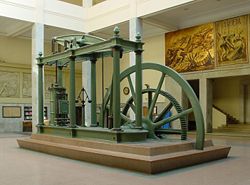|
|
| (2 intermediate revisions by the same user not shown) |
| Line 1: |
Line 1: |
| | {{Main page article box| | | {{Main page article box| |
| | type=Featured| | | type=Featured| |
| − | title=Medicine wheel| | + | title=Industrial Revolution| |
| − | image_name=bighorn medicine wheel.jpg| | + | image_name=Maquina vapor Watt ETSIIM.jpg| |
| − | image_desc=Medicine Wheel in Bighorn National Forest, Wyoming| | + | image_desc=A [[Watt steam engine]], the [[steam engine]] that propelled the Industrial Revolution in [[Britain]] and the world| |
| − | text='''Medicine wheels''', or '''sacred hoops''', are [[stone structure]]s built by certain [[Indigenous peoples of the Americas]] apparently for [[astronomy|astronomical]], [[ritual]], healing, and [[teaching]] purposes. They were constructed by laying stones in a particular pattern on the ground. Most medicine wheels resemble a [[wagon]] [[wheel]], having a center [[cairn]] of stones surrounded by an outer ring of stones, and then "spokes," or lines of rocks, coming out from the cairn. The outer rings could be large, reaching diameters of as much as 75 feet. They were often constructed at or near the summit of a hill. | + | text=The '''Industrial Revolution''' was a transformation of human life circumstances that occurred in the late eighteenth and early nineteenth centuries in Britain, the United States, and Western Europe. It was characterized by a complex interplay of changes in [[technology]], [[society]], [[medicine]], [[economy]], [[education]], and [[culture]] in which multiple technological innovations replaced human labor with [[work|mechanical work]], replaced [[vegetable]] sources like [[wood]] with [[mineral]] sources like [[coal]] and [[iron]], freed mechanical power from being tied to a fixed running water source, and supported the injection of [[Capitalism|capitalist]] practices, methods, and principles into what had been an agrarian society. |
| − | | |
| − | Medicine wheels are found in the prairie regions of [[Canada]] and the [[United States]], such as [[Alberta]], [[Manitoba]], [[Saskatchewan]], [[Wyoming]], and [[Montana]]. They were commonly used by the [[Ojibwa]] and [[Anishinaabe]] peoples, some structures dating back as much as 4,500 years. Some, such as the Bighorn Medicine Wheel, continue to be used by [[Native American]]s for religious ceremonies.
| |
| − | | |
| − | While the original purpose of these stone structures is not known with certainty, they provide an intriguing link to the lives and culture of those who lived long ago.
| |
| | }} | | }} |

A Watt steam engine, the
steam engine that propelled the Industrial Revolution in
Britain and the world
The
Industrial Revolution was a transformation of human life circumstances that occurred in the late eighteenth and early nineteenth centuries in Britain, the United States, and Western Europe. It was characterized by a complex interplay of changes in
technology,
society,
medicine,
economy,
education, and
culture in which multiple technological innovations replaced human labor with mechanical work, replaced
vegetable sources like
wood with
mineral sources like
coal and
iron, freed mechanical power from being tied to a fixed running water source, and supported the injection of capitalist practices, methods, and principles into what had been an agrarian society.
